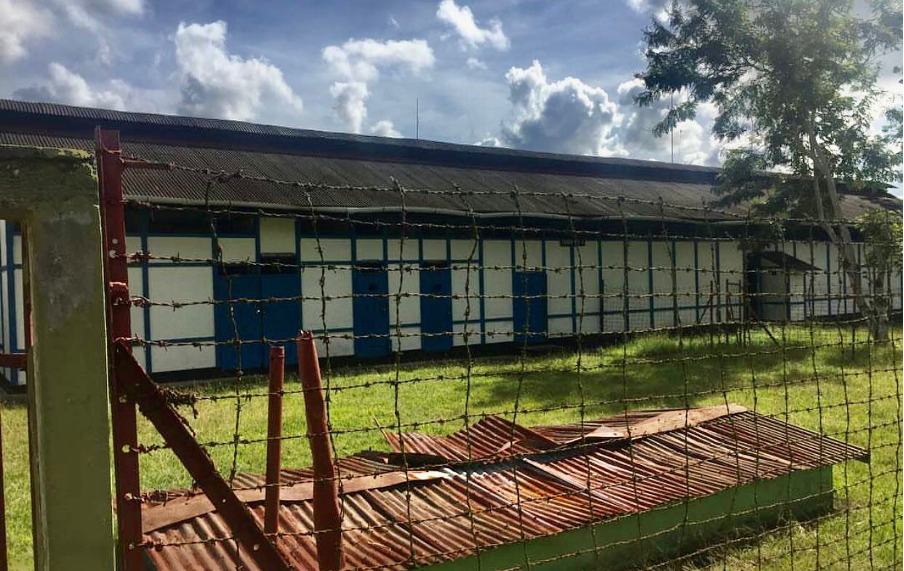Word: Ayu Arman
A Journey Through Time in the Prison Site of Tanah Merah”

When arriving at Tanah Merah Airport, one is immediately greeted by the statue of Mohammad Hatta at a street junction, directly across from the Boven Digoel Police Headquarters, built in 2004. The statue of the Proclaimer of Independence stands as a powerful symbol that Boven Digoel once played a pivotal role in Indonesia’s struggle for independence.

This region, once remote and feared, became a site of profound historical significance. As recorded in history books, in 1907, during a Dutch military expedition to assert control over Papua, Dutch troops navigated 540 kilometers of the Digul River upstream. Back then, Tanah Merah was a desolate land inhabited by indigenous tribes, ravaged by malaria, and surrounded by crocodile-infested swamps. These conditions made it an ideal location for the Dutch to establish an exile camp—one from which escape was nearly impossible.
Even before Dutch exploration, Boven Digoel was already known to Chinese traders in Merauke who hunted the brilliant-feathered bird of paradise for women’s hat decorations. Following a massive communist uprising in 1926–1927 in Banten and West Sumatra, Dutch Captain L. Th. Becking was ordered to establish a detention site in Tanah Merah on January 26, 1927, accompanied by 120 soldiers, 60 laborers, and the first convoy of 1,300 political prisoners.

Among the prominent national figures who were detained here were Bung Hatta, Chalid Salim, Sutan Sjahrir, and Bondan, who arrived on February 22, 1935, before being transferred to Banda Naira on January 30, 1936. Other notable prisoners included Aliarcham, Sardjono, Mohammad Sanoesi, Soenario, Soemantri, Dachlan, and Najoan. In 1929, the camp reached its peak population of 2,100 detainees, comprising 1,170 men, 400 women, and 500 children. Around 1,500 were repatriated over the course of a decade.
Hatta and Sjahrir had only briefly stayed here before being moved to Tanah Tinggi Prison, located three hours upriver. This special facility was reserved for the most politically sensitive prisoners.

Visiting these places feels like a pilgrimage, a way of paying tribute to the heroes of Indonesian independence. There were once three prison sites in Boven Digoel:
- Tanah Merah Prison
- Gudang Arang Prison (now lost to river erosion)
- Tanah Tinggi Prison (now only ruins and a memorial plaque remain)
The Tanah Merah prison complex consists of three main structures:
- A barrack that held about 30 prisoners
- A storeroom for utensils
- Three individual holding cells
- A central area with a water tank, kitchen, and bathroom
- On the right side of the main gate: 4 small cells (2×2 meters each), a 4×5-meter barrack, and a latrine
Today, the site is maintained by the Boven Digoel police, who also use the facility to discipline internal personnel. Behind the prison stand two large buildings (50 x 15 meters) now serving as police barracks.
To the side of the prison site are two more buildings:
- The former Dutch police guardhouse, now the Police Headquarters
- A residential house now used as the Police Chief’s residence
Other colonial-era buildings have been repurposed as the post office, Mandobo police station, and residences for local civilians. About 1.5 km away, in Kampung Wet, lies the Tanah Merah Heroes Cemetery, home to 42 graves of both fallen patriots and respected local figures. Today, the Tanah Merah prison site has become increasingly well-known, attracting both domestic and international visitors—especially descendants of those once exiled here or relatives of Dutch colonial personnel. This site is more than just stone and timber; it is a living archive of sacrifice, resistance, and remembrance. Through comparing archival photographs with current images, we see the layers of transformation, not just in architecture but in national consciousness. These visuals serve as reminders that while buildings age, the spirit of resistance and the price of freedom must never be forgotten.

